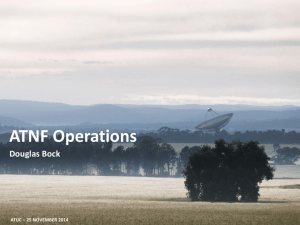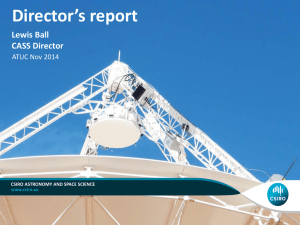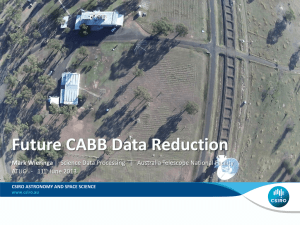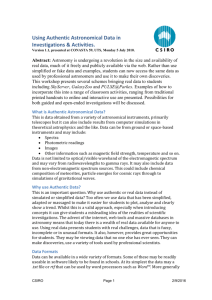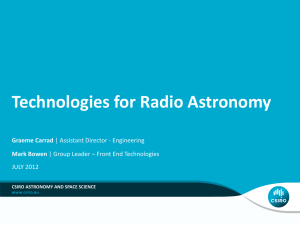We assume that the negative feedback referred to by ATUC refers
advertisement
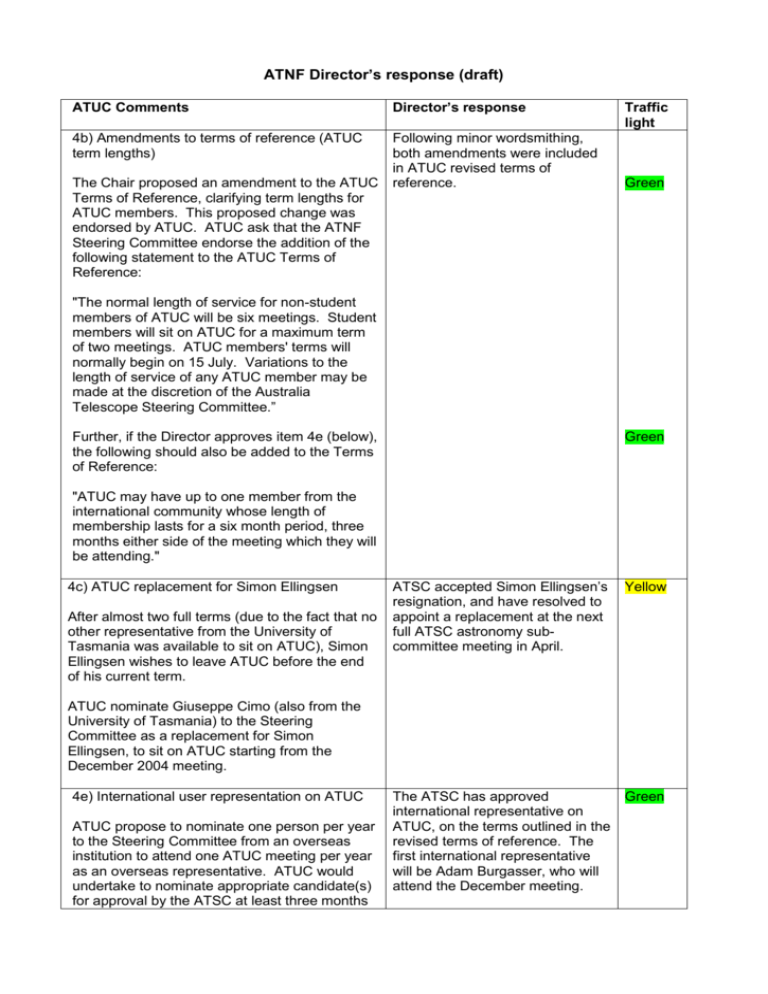
ATNF Director’s response (draft) ATUC Comments Director’s response 4b) Amendments to terms of reference (ATUC term lengths) Following minor wordsmithing, both amendments were included in ATUC revised terms of reference. The Chair proposed an amendment to the ATUC Terms of Reference, clarifying term lengths for ATUC members. This proposed change was endorsed by ATUC. ATUC ask that the ATNF Steering Committee endorse the addition of the following statement to the ATUC Terms of Reference: Traffic light Green "The normal length of service for non-student members of ATUC will be six meetings. Student members will sit on ATUC for a maximum term of two meetings. ATUC members' terms will normally begin on 15 July. Variations to the length of service of any ATUC member may be made at the discretion of the Australia Telescope Steering Committee.” Further, if the Director approves item 4e (below), the following should also be added to the Terms of Reference: Green "ATUC may have up to one member from the international community whose length of membership lasts for a six month period, three months either side of the meeting which they will be attending." 4c) ATUC replacement for Simon Ellingsen After almost two full terms (due to the fact that no other representative from the University of Tasmania was available to sit on ATUC), Simon Ellingsen wishes to leave ATUC before the end of his current term. ATSC accepted Simon Ellingsen’s resignation, and have resolved to appoint a replacement at the next full ATSC astronomy subcommittee meeting in April. Yellow The ATSC has approved international representative on ATUC, on the terms outlined in the revised terms of reference. The first international representative will be Adam Burgasser, who will attend the December meeting. Green ATUC nominate Giuseppe Cimo (also from the University of Tasmania) to the Steering Committee as a replacement for Simon Ellingsen, to sit on ATUC starting from the December 2004 meeting. 4e) International user representation on ATUC ATUC propose to nominate one person per year to the Steering Committee from an overseas institution to attend one ATUC meeting per year as an overseas representative. ATUC would undertake to nominate appropriate candidate(s) for approval by the ATSC at least three months prior to the meeting in question. It would normally be expected that the overseas member would not require support from the ATNF for international travel (i.e. that the overseas member would be in Australia for other purposes e.g. observing near to the time of the meeting) but that the ATNF would support reasonable requests from the international member for local travel and subsistence costs incurred in attending the ATUC meeting. In this way the nominee will have had immediate experience with ATNF facilities and will be able to give appropriate input to the ATUC meeting. Will the ATNF approve this proposal? 6a) ATUC recommend that ATNF base their negotiations with NASA on a broad-band (26 – 50 GHZ) upgrade to the ATCA, in preference to a system that only operates in the narrow Ka band required for spacecraft tracking. The proposed 7mm system will be based around broadband capability for astronomical use. This has been made clear to NASA from the outset of negotiations and forms the basis for the ‘co-investment’ nature of the contract. Green ATUC note a conflict between the current scheduling arrangements for the ATCA and the proposed NASA method of scheduling the potential 7mm system for spacecraft tracking. The NASA schedule would only be known 4 – 8 weeks in advance, while ATCA schedules are produced for a period of six months at a time (note that the same problem would occur for the old four month terms). ATUC would like to be sure that scheduling of the 7mm system will not significantly impact on astronomer usage of the ATCA. How would the ATNF propose to deal with scheduling NASA tracking, given the mismatch in scheduling timescales? Users’ and indeed ATNF’s, concerns over scheduling have been communicated to NASA. Green ATUC suggest that a science case be formulated sooner rather than later so that we can provide input on detailed receiver specifications. An initial science case has been prepared by Enno Middelberg (7mm project scientist) with input from the community. The science case will be maintained under version control. Green How will the development of the 7mm system impact on other activities of the receiver group over the next few years? On the basis the 7mm system will proceed, ATNF have consolidated the resource requirements on the receiver group over the forthcoming year. This has led to the identification that a further technician will be required to mitigate resource risks to delivery time scales. Approval has been Green As a result the agreed functional requirements document now includes the requirement than NASA must give advance notice of all major scheduling requirements consistent with ATNF’s scheduling period. ATNF have agreed that, in exceptional circumstances (i.e. up to a maximum of 4 times per year) that later changes to the schedule may be accommodated 6b) Does ATUC have any comments on how to optimally schedule winter time e.g. mm + cm swaps, proposals deferred across semesters, separate ranking schemes for mm and cm proposals, etc? (question from ATNF) ATUC recommend that millimetre observing slots continue to be partnered with centimetre observing slots or Director's Time (DT) to allow for swapping if the weather is unsuitable for mm observing. ATNF should seek to encourage more swappable centimetre projects through heavy promotion, including via the call for proposals. Furthermore, once the ATCA schedule has been determined (including possible swaps), a separate announcement to the user community advertising the availability of swappable DT could be made. This announcement would include details of possible dates, LST ranges, configuration, etc. for each slot and users would be encouraged to submit requests to the Director. Applicants for swappable DT who are also duty astronomer for the period requested should be given priority. If local or service observing of an approved DT project proves difficult to arrange, remote observing should be made available to both domestic and qualified overseas observers. 6c) How does ATUC rank the proposal to put 16 MHz filters on the 2nd IF for mm observations? (question from user via Ott presentation) given to proceed with recruitment of a technician Maximising the science coming from the ATCA in winter is clearly a priority. With the arrival of the full millimetre system, the current swap scheme appears unable to meet the requirements to achieve this. The ATNF will present a proposal at the December ATUC meeting. Yellow A key factor in determining the most appropriate observing models is a more detailed understanding of the mmconditions of the site. As such ATNF would anticipate than observing models may evolve as greater understanding of the site conditions is gained through further monitoring. . The proposal was subsequently approved to proceed by ATNF project review board, with appropriate allocation of resources. Project completion is scheduled for the start of the 2005 mm season. Green 6e) Does ATUC support the straw man proposal for Mopra operations? (question from ATNF) ATNF will endeavour to maintain Mopra's availability for VLBI. Yellow The restriction to observing April-November only is unacceptable from a VLBI perspective. The LBA schedule is already severely constrained by the availability of Tidbinbilla. Blocking the use of Mopra from December to March would mean that any large allocations of Tidbinbilla time during this period could not be efficiently used. The future availability of Mopra should not constrain LBA scheduling any more than it is currently. From resource considerations, ATNF would be prepared to support an initial 'not greater than' 50% target for non-survey applications, while recognising that the detailed fraction of time will be largely fixed by the competitiveness of the proposals. Yellow ATUC rank this proposal very highly and recommend that ATNF implement it as soon as possible to take maximum advantage of the 12 and 3 mm systems prior to the CABB coming online. It seems that this relatively simple and inexpensive project will greatly enhance the efficiency and scientific usefulness of the ATCA for 12 and 3 mm observations. The 25% community time may be too small and ATNF should consider increasing it to between 25 and 50% depending on user demand. ATUC would not like small users to be discouraged from applying for Mopra time, especially given the recent closure of SEST. As a result of uncertainties in the delivery time of the Mopra spectrometer, the opportunity for large surveys at Mopra has not been strongly advertised for the 2005 season. ATUC strongly endorse the remaining points in the straw man model, especially the aim for full remote observing by 2005. To ensure that appropriate resources are devoted to the program and progress is monitored appropriately, this project has now been formally adopted with the ATNF project management structure. Green 6f) ATUC are concerned by the impact of increased RFI in the 50 cm band at Parkes over the next two years (raised by ATUC) Various options to mitigate the effects of interference from broadcast TV services at Parkes in the 50cm band are under active consideration, including moving the observing band upwards in frequency, modifying the receiver, and employing active signalprocessing cancellation techniques. A full report on the status of these will be presented at the next ATUC meeting. Green ATUC see a strong need to move away from the currently used band for the 10/50cm receiver due to increased RFI from digital TV transmissions. ATUC request that the ATNF undertake a feasibility study to determine what resources are required to modify or replace the existing 10/50cm system in order to access relatively clear spectrum. Even if the 50 cm band is shifted, ATUC see an ongoing need for RFI mitigation efforts at Parkes in the 50cm band. ATUC request a report on this at the December 2004 ATUC meeting. Hopefully ATNF are now keeping an eye on the frequencies of future digital TV transmitters, even when they are hundreds of km from the Observatories, and planning the frequency ranges of future receivers accordingly. 6g) ATUC recognise that the potential scientific and technical benefits of eVLBI clearly identify these developments as the future of Australian VLBI. ATUC endorse the project plan put forward subject to the following points: ATUC recommend that real-time correlation with the LBA correlator (phase C of the project plan) be dropped from the project plan. The resources required to execute this part of the plan are not justified in terms of the science return and the resources will be better expended on other parts of the project. ATUC recognises that the ultimate science case for e-VLBI requires broadband receiver upgrades at Parkes as well as at all non-ATNF antennas. ATUC ask the ATNF to consider coordinating a plan for the broad-band upgrade of these Since TV transmissions have been detected as far away as 300km, ATNF are making every effort to keep abreast of all changes in to licenses and tranmissions that might affect observations, particuarly TV broadcasts. The project was given initial approval to proceed to Phase B. Phase C has been dropped. Green The project is making good progress, although there are concerns over the time scale for the availability of the AARNET3 network. ATNF acknowledge that this would indeed be desirable. However, it would also need to be considered against other major upgrades (extending NS baseline Yellow antennas to match the expected performance of the ATCA and Mopra broad-band upgrade. ATUC note that the “MNRF-3-like” funding opportunity expected for 2006 would be an appropriate and timely mechanism for supporting a project of this size and complexity. on ATCA, xNTD) also appropriate for MNRF funding (actually the systemic infrastructure fund) on this time scale. This may be most appropriately addressed in the Decadal Planning process. 6h) ATUC is concerned by the number of negative comments it has recently received regarding feedback on proposals submitted to the ATNF TAC (raised by users) We assume that the negative feedback referred to by ATUC refers primarily to the TAC comments on the proposals submitted for the 2004 MAYT. At the most recent TAC meeting, held in late-June 2004, the TAC put additional effort into providing clearer comments and to checking these. It would be useful to hear back from ATUC whether the amount of negative feedback for the 2004OCTS was reduced. ATUC received correspondence representing approximately 15 users from both within Australia and overseas, complaining about the quality of TAC comments on observing proposals. Many specific negative views were expressed but the common theme was that, in a number of cases, the comments indicated a significant lack of understanding of the science in question. From what ATUC understand of the TAC process, we think that it is likely that the TAC comments in some cases do not reflect the high level of consideration given to proposals by the TAC. Green . We would like the TAC to review its methods of generating comments on proposals, with the aim of making the content more uniform across proposals and a better reflection of the TAC process. 6i) ATUC would like to help the ATNF develop some criteria for the success of 6 month terms (raised by users and ATUC) and ATUC have some suggestions for the improvement of six month scheduling (raised by ATUC). Several criteria for the success of 6 month terms were discussed by ATUC. Basically the success or otherwise of 6 month terms will be very difficult to measure quantitatively as it is only one of a number of variables that affect proposal statistics. However, it is worth attempting to track the following statistics (some of these are already tracked). Six month terms should be considered a success if: Publication rates from ATNF telescopes rise or remain constant (very difficult to track the effects of one variable in this); The total time awarded to proposals for which the PhD “yes” box is checked rises or remains constant (an interesting statistic to track student participation); The oversubscription rates rise or stay constant (again difficult to quantify in terms of ATNF routinely reports on publication rates, oversubscription rates and VLBI usage with annual performance figures provided in the annual reports. There has been no measurable decrease in any of these so far and the publication rates for 2004 are high. The administrative load on the ATNF and TAC has decreased signficantly following the change to six-month terms. ATNF will provide an analysis of PhD use and publication numbers at the December ATUC meeting, as part of the NFS report. The telescope schedules have to take into account many different requirements including (for ATCA) configuration changes. This means that it is not possible to guarantee that student or pilot programs can be scheduled early in the term although this will be taken into account where possible. Yellow one variable); VLBI usage of highly constrained antennas such as Tidbinbilla increases or remains constant (should be a relatively straightforward measurement to make and interpret); Administrative load on the ATNF and the TAC is decreased. Total person hours spent on TAC matters should decrease; Users are satisfied. ATUC will survey users after the first full 6 month term to assess their level of satisfaction with 6 month terms. Observers are encouraged to use the question on the application form that asks for information on scheduling requirements. ATUC also have some suggestions for improved implementation of 6 month terms. ATUC suggest the scheduling of clearly identified pilot projects early in the term to give investigators the maximum opportunity to propose for the major observing program in the following semester. Similarly, for proposals identifying PhD projects, scheduling early in the semester would give PhD students the maximum chance to obtain data for their theses. ATNF considers that adding an different category of NAPA would cause confusion to users. NAPA proposals are those where observing dates cannot be determined in advance. As above, observers can stress their scheduling requirements on the application form as well as in the science case. Red 6 j) ATUC endorse what appears to be a very sensible plan for evaluating a number of different technology options on a feasible timescale, underpinned by the developments to date in terms of radio quiet reserves in Western Australia and connections to international partners. ATUC do recommend that the NTD have a strong science component and that this science component be detailed at the next ATUC meeting. ATUC’s strong desire for a science component has, in part, led to the xNTD proposal. The xNTD science case was distributed with the SKA roadmap to the community in late October. Green ATUC request that ATNF look at the possibility of pushing the upper frequency limit of the NTD as high as possible. In particular, if the upper frequency can be pushed to 1.7 GHz, the NTD can co-observe with the Tidbinbilla 70m antenna, all of the ATNF antennas, and Hobart, as part of the Australian VLBI array. Given the strong overlap between some of the NTD technology and the ATNF e-VLBI project, ATUC feel that operation at as high a frequency as possible would be advantageous to the NTD science case An upper frequency limit of 2.4GHz has now been included as a goal in the NTD specifications. Green ATUC suggest that a category of NAPA proposal could be created for simultaneous observations with other facilities. The only difference between this category of NAPA and the usual NAPA would be that the data would not be subject to the usual rapid data release rules. as well as its SKA technology demonstration case. 8a) What is the ATNF policy on sharing data for observations of the same source, at the same time, using the same telescope, but sharing the IF signal to feed completely different sets of instrumentation? For example, at Parkes one user may request an observation of a pulsar with CPSR2 while another may wish to observe the same object with WBCORR. In general data taken for an observer belongs to the observer under the normal data access rules. If two observers simultaneously take data for two separate projects then each observer 'owns' the data for their project. Green 9a) A user has requested that the following “local folklore” be documented in the Users’ Guide: a) What are typical calibrator duty cycles for different weather conditions? b) How common are DC offsets and how are they recognized? c) How close and how strong should a secondary calibrator source be to a target? d) Should averaging be used? e) What is the best way to set delays for narrow-band observations? f) What are typical integration times for mosaic observations? Of those points not previously documented, we have ensured that they are all covered in either the ATCA Guide to Observations, the ATCA Users Guide, or by some web tools. Green 9b) Users would like to see 13cm polarization performance improved. This should be done as part of the broadband upgrade. Is this possible? This will be part of the broadband cm receiver upgrade, which has been approved to proceed to the planning stage by the ATNF project review board. The science requirements will be discussed at the forthcoming ATUC meeting. Significant changes to off-line software have been announced through a number of channels, including the ATNF Newsletter and the astro majordomo. Green Although routine replacement of carpeting and repainting in the living areas and office are planned during this summer, no major improvements to Mopra accommodation facilities are planned. Mopra is moving to a mode of remote use, and so visits to Mopra are expected to decrease. Red 9d) New ATLOD version in Miriad (raised by ATUC) ATUC request all ATCA users are notified of the new version of ATLOD that will be required for ATCA 12 mm observations and any other future important MIRIAD upgrades. This may be best done via the “Call for Proposals” email exploder. 10b) ATUC request that the ATNF review the quality of observer accommodation at Mopra, given that the cost per night is comparable to the lodge at the ATCA. ATUC recognize that accommodation costs at Narrabri benefit by economy of scale. However, making Mopra as attractive as possible to observers may also encourage more users. Perhaps if making extra facilities available is not possible, a reduction in the accommodation cost may be possible. Mopra accommodation is already substantially subsidised, and undercuts other local options. Green 11a) A user has requested a higher level link on the ATNF web pages to proposal and observation preparation tools that are available on the Parkes web page. Done 11b) Does ATUC have any comments on the development plans for the pulsar archive? (question from ATNF) ATUC think that the recommendations look good but ask, how does the ATNF plan to archive past data collected at Parkes? For example, the only copy of datasets taken during a period of many years now resides on tapes owned by individual users and distributed around the world. ATUC suggest that future Parkes data should be archived at the observatory as a matter of course. 11c) ATUC thank John Reynolds for the receiver status report with timescales. By the next observing deadline ATUC would like to know the schedule for receivers that will be operational at Parkes (similar to the announcement of the configurations planned ahead of time for the ATCA) over the duration of the next two semesters. This information should be included in subsequent calls for proposals. Green Green A Pulsar archive implementation paper addressing these issues has been developed by the ATNF, with input from ATUC. The ATNF is now in the process of working through the implementation tasks. The information & WWW references contained in the latest call for ATNF observing proposals provides all relevant information for proposers concerning receiver availability at Parkes for the next Term. Green ATNF are investigating the possibility of cheaper student accommodation in Canberra with ANU colleges and the RSAA Director. Unfortunately, the possibility of mountain-top accommodation does not exist. Yellow ATNF are currently reviewing the management of the pages, and will update ATUC with further Yellow ATUC will consult with users as to the best date for phase 2 of the 21cm multi-beam receiver refurbishment, since the schedule for this is somewhat flexible. 12a) Subsidised accommodation in Canberra for ATNF-co-supervised students (raised by user) Currently ATNF-co-supervised students that stay in ATNF accommodation at Marsfield (to visit supervisors) or the Observatories pay no accommodation costs. There is no such arrangement for ATNF-co-supervised students visiting ATNF supervisors in Canberra, amounting to a financial penalty for these students. ATUC recommend that ATNF investigate options for bringing ATNF cosupervised student accommodation in Canberra into line with arrangements for Marsfield, Parkes, ATCA and Mopra 13a) A user has requested that the most important LBA web pages kept up to date, these being: information at the meeting. a) Documentation pages describing system parameters; b) Available frequencies; c) Proposal status; d) Standard observing modes available 14c) SPC replacement software (raised by ATUC) A report on SPC will be provided at the next meeting. . Green Noted and agreed. ATUC will have an opportunity to review the RVS project at the forthcoming meeting. Noted. ATUC priorities will be taken into consideration in issues of resource conflict. Green ATUC are very encouraged by the concrete progress toward the SPC replacement software and look forward to more substantial progress before the next ATUC meeting 14d) ATUC would like to see evidence that RVS will be a unique and widely used product before endorsing significant expansion of this project. 15c) ATUC ranked the importance of these projects to the ATNF and its user community as follows: 1. 2. 3. 4. 5. CABB (Compact Array Broadband Backend) NTD (New Technology Demonstrator) Methanol Multi-beam eVLBI ATCA 7mm system ATUC recognized that the CABB and NTD are integral to the success of the contracted work under the MNRF program and therefore of the highest priority – CABB is more likely to be directly important for users and has the highest priority. The Methanol Multi-beam was recognized as a large project that is currently underway with a need to be pushed to completion in order to service what appears to be a strong user community. e-VLBI was seen as a high value project with good potential outcomes from modest effort and expenditure in the short term, which gives it a lower priority over at least the next 12 months. Finally, the 7 mm system is seen as a very important development for the ATNF but in the context of the next major project to be undertaken once the four higher priority projects have attained further progress. Responses 24 Green 8 Yellow 2 Red 71% 23% 6% Green
